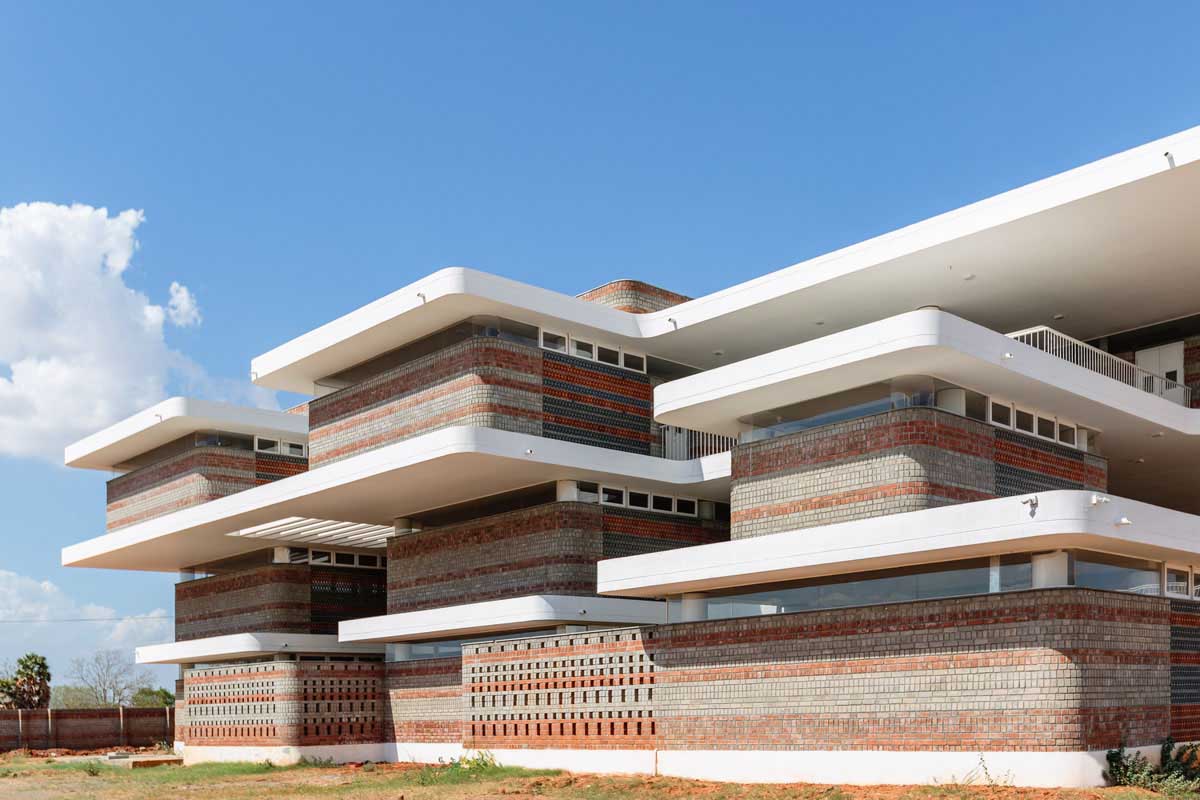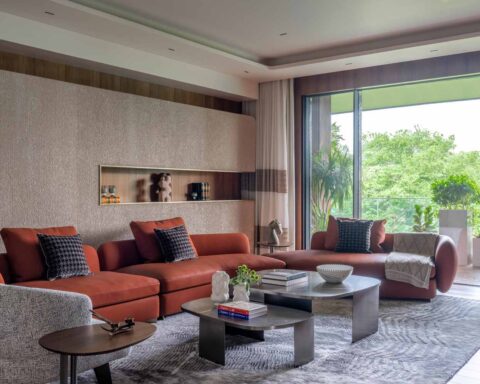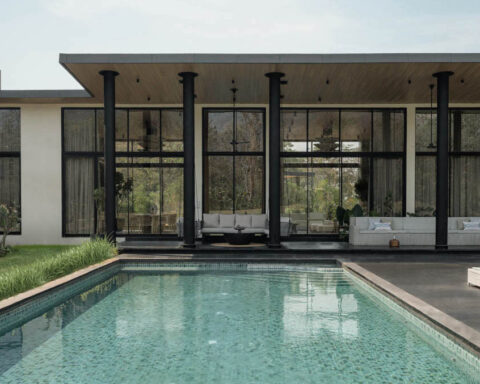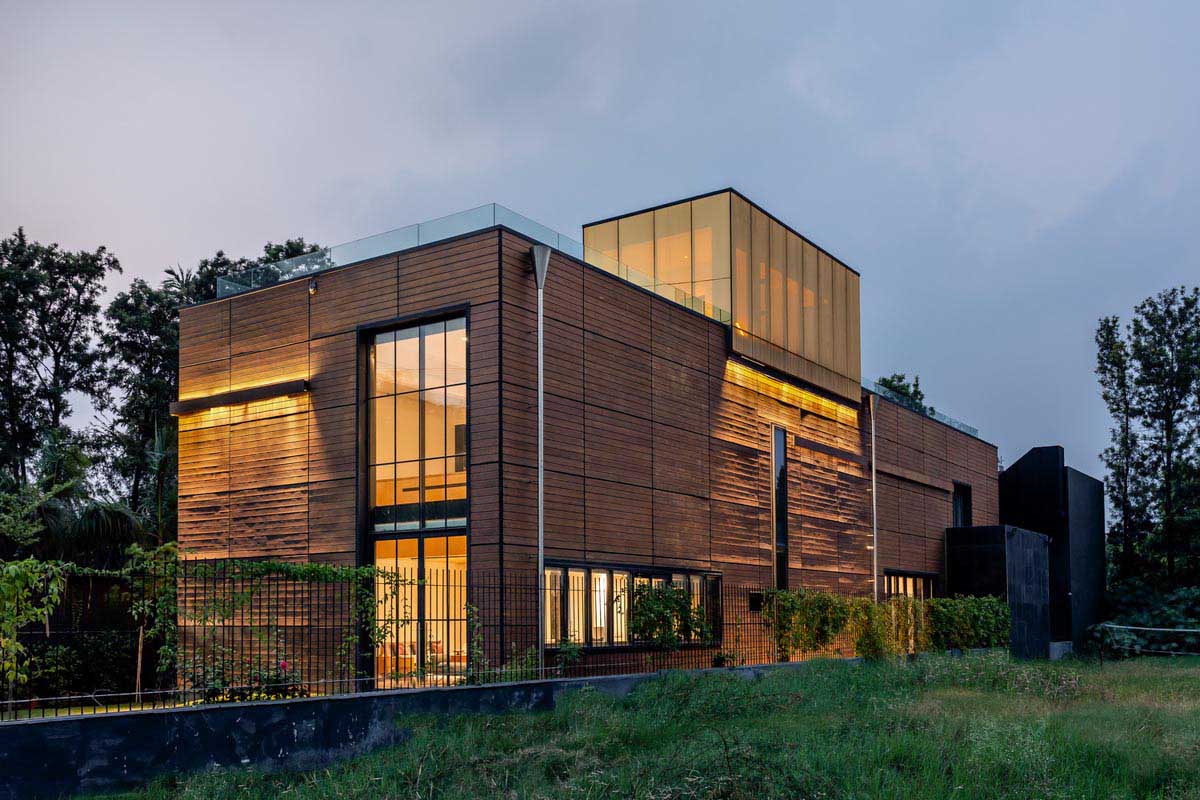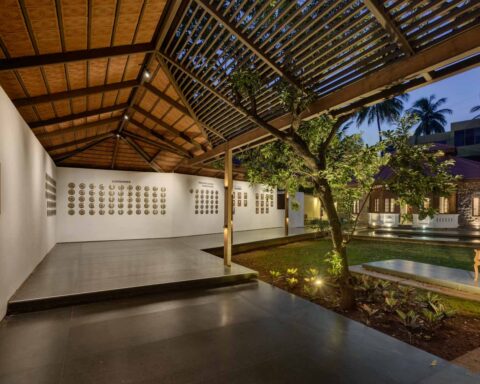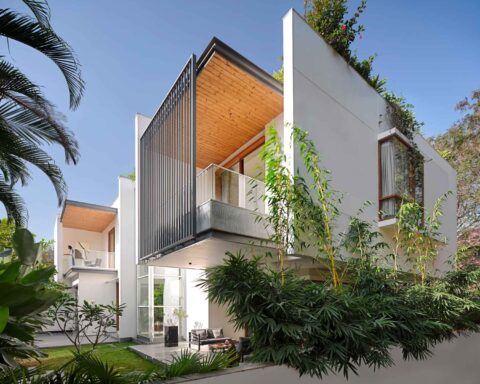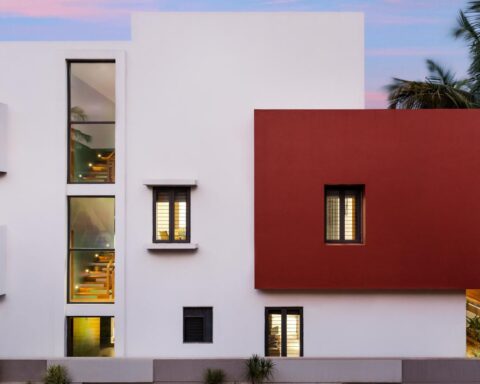[vc_row][vc_column][vc_custom_heading text=”This school in rural India is built using smart low cost construction techniques.” use_theme_fonts=”yes”][/vc_column][/vc_row][vc_row][vc_column][vc_column_text]Project Name : Rane Vidyalaya School
Project Location : Theerampalayam, Tamil Nadu, India
Project size : 5000 sq. m.
Architects/Designer : Shanmugam Associates
Project Status : Built[/vc_column_text][/vc_column][/vc_row][vc_row][vc_column][vc_single_image image=”17066″ img_size=”full”][vc_single_image image=”17068″ img_size=”full”][/vc_column][/vc_row][vc_row][vc_column][vc_column_text]
Text description by the architects.
Rane Vidyalaya CBSE school is an educational campus for K12 and a CSR initiative by Rane Foundation India Pvt. Ltd, a leading industrial conglomerate. Theerampalayam, the rural region where the school is located, has no proper educational institutions that offer quality learning. The closest city, Tiruchirapalli which is a Tier-II city in the state of Tamil Nadu, India, is 20 kms away. Neighborhood districts are a mix of small rural villages whose occupation is agriculture and unskilled labor. The project was envisioned as a whole but executed in two phases. Presently Phase 1 has been constructed for an area of 50,000 Sq.Ft. The intent was to create an infrastructure that would have a positive social impact on the local community and also showcase the core values of Rane.
[/vc_column_text][/vc_column][/vc_row][vc_row][vc_column][vc_single_image image=”17066″ img_size=”full”][vc_single_image image=”17069″ img_size=”full”][/vc_column][/vc_row][vc_row][vc_column][vc_column_text]
Construction techniques from regional context, structured pedagogy of the Indian educational system and construction cost of $20 / Sq.Ft formed the underlying basis for the design development. Inspiration came in from the 6th century built Thiruvellarai temple’s walls and the layered cross sections of 50 year old houses in the region. Construction methodology, that was followed consistently in these walls, was layering starting from huge random rubble and stone at bottom, to finer solid brick work, mud and slate on top. Alternating wall layers of red wire cut bricks from local kiln and grey fly ash brick recycled from industrial cement waste were used.
[/vc_column_text][/vc_column][/vc_row][vc_row][vc_column][vc_single_image image=”17071″ img_size=”full”][vc_single_image image=”17070″ img_size=”full”][/vc_column][/vc_row][vc_row][vc_column][vc_column_text]
The kindergarten classrooms are designed to have individual gardens that encourage seamless outdoor and indoor integration of space. With every increase in grade, classes become more functional to induce structured learning. The overall design approach was to avoid sharp edges in walls, columns, slab edges and in every detail possible to ensure safety. Located in the tropical belt of interior Tamil Nadu, the intent was to have the space ventilated naturally with sufficient lighting.
[/vc_column_text][/vc_column][/vc_row][vc_row][vc_column width=”1/2″][vc_single_image image=”17073″ img_size=”full”][/vc_column][vc_column width=”1/2″][vc_single_image image=”17072″ img_size=”full”][/vc_column][/vc_row][vc_row][vc_column][vc_single_image image=”17074″ img_size=”full”][/vc_column][/vc_row][vc_row][vc_column][vc_column_text]
All walls are stopped at lintel height and have open-able windows above, to allow hot air to dissipate and increase cross ventilation. Terracotta jalli has been used as secondary shading devices. Major openings along the predominant SE & NW wind direction and minor wind tunnels in east-west direction between classrooms are created to have a comfortable micro-climate. Taking inspiration from temple mandapams where huge gatherings took place, there is an enclosed central courtyard planned with perforated light wells in the roof. This courtyard would serve as a multi functional place of congregation for lunch breaks, school assembly, exhibition space, co-curricular training and small gatherings.
[/vc_column_text][/vc_column][/vc_row][vc_row][vc_column width=”1/2″][vc_single_image image=”17078″ img_size=”full”][vc_single_image image=”17079″ img_size=”full”][/vc_column][vc_column width=”1/2″][vc_single_image image=”17077″ img_size=”full”][vc_single_image image=”17076″ img_size=”full”][/vc_column][/vc_row][vc_row][vc_column][vc_column_text]
The courtyard is placed in such a way that it is visually connected at all levels. All these architectural features, incorporating use of red solid bricks, baked earth tiles, terracotta jalli and grey fly ash bricks, help address the micro climate, create interesting light & shade experiences through roof perforations, provide safe green courtyards and sufficient ventilation. At the same time they also speak the design language of the local region, source material from the surrounding area, create a fun educational environment and give a wholesome cost effective solution.
[/vc_column_text][/vc_column][/vc_row][vc_row][vc_column][vc_single_image image=”17075″ img_size=”full”][/vc_column][/vc_row][vc_row][vc_column][vc_column_text]
Photographer: LINK Studio.
[/vc_column_text][/vc_column][/vc_row][vc_row][vc_column][vc_column_text]PROJECT CREDITS
Architecture: Shanmugam Associates, Chennai.
Lead Architects: Ar. Shanmugam A, Ar D Rajakrishnan, Ar Santhosh Shanmugam
Design Team: Srinivasan, Sathish Kumar, Balasubramaniam, Mohamed Ismail, Rukmani Thangam, Praveen Kumar
Clients: Rane Foundation, Chennai
Engineering: Hitec Construction, Trichy
Structural Consultants: Ramkumar, Rays Consultants, Bengaluru
Landscape: Shanmugam Associates, Trichy & Chennai
Electrical Consultants: DNR, Trichy
Plumbing Consultants: D&D, Coimbatore
[/vc_column_text][/vc_column][/vc_row]





